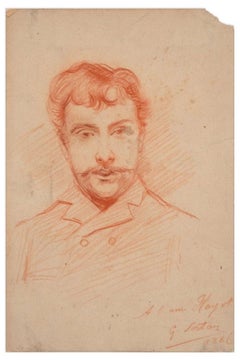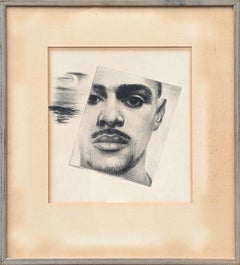Georges Julien Sortais Art
1860-1930
Georges Julien Sortais was born in Paris in 1860. He was a pupil of Gustave Jacquet, who was his uncle. Soratais worked with the famous gallery owner Georges PETIT who was one of the keys to the art market of his time in Paris and one of the main promoters of modern painting. He was a painter, an art writer and expert in works of art (Drouot archives). He had specialized in the Renaissance.
to
1
Overall Width
to
Overall Height
to
1
1
1
1
1
1
1
1
1
10,042
2,762
1,381
1,375
Artist: Georges Julien Sortais
Portrait of a Man - Original Pencil Drawing by G.J. Sortais - 1886
By Georges Julien Sortais
Located in Roma, IT
Man Portrait is a beautiful portrait drawn with a sanguine pencil by the French artist Georges Julien Sortais. The state of preservation is very good, except for some stains of funga...
Category
Late 19th Century Modern Georges Julien Sortais Art
Materials
Pencil
Related Items
"Contemplation"
By Gershon Benjamin
Located in Lambertville, NJ
Jim’s of Lambertville is proud to offer this artwork by:
Gershon Benjamin (1899-1985)
An American Modernist of portraits, landscapes, still lives, and the urban scene, Gershon Benj...
Category
1920s Modern Georges Julien Sortais Art
Materials
Graphite
Modern Early Black and White Charcoal Artist Self Portrait Drawing
Located in Houston, TX
Modern early black and white artist self portrait by Houston artist Edsel Cramer. The work features a young portrait of the artist staring directly forward and cropped within an off-...
Category
1940s American Modern Georges Julien Sortais Art
Materials
Paper, Charcoal, Graphite
$1,500
H 18.75 in W 16.75 in D 0.5 in
A Handsome 1940s Portrait of a Seated Man by Chicago Artist, Harold Haydon
By Harold Haydon
Located in Chicago, IL
A Handsome 1940s Portrait of a Seated Man by Chicago Modern Artist, Harold Haydon (Am. 1909-1994). A wonderfully executed line drawing dating from 1946 with great character; looks ...
Category
Mid-20th Century American Modern Georges Julien Sortais Art
Materials
Paper, Graphite
$135
H 20 in W 16 in D 0.13 in
Young man in a toga elegant man Latin American hyperrealist Hockney style
By Claudio Bravo
Located in Norwich, GB
Superb original drawing in coloured conté pencils, heightened with white on oatmeal coloured vergé paper by Claudio Bravo. The work was created during the artist's Moroccan period, a...
Category
1970s Modern Georges Julien Sortais Art
Materials
Conté, Laid Paper, Color Pencil
$7,500
H 30.32 in W 24.02 in D 0.4 in
Chef Basting Chicken with Madeline Watching
By Ludwig Bemelmans, 1898-1962
Located in Miami, FL
This large Bemelans features a small image of Madeline in the smoke behind the chef's face. It was most likely preliminary work for an illustration with Madeline and the Chef that a...
Category
1950s American Modern Georges Julien Sortais Art
Materials
Paper, Watercolor, Gouache, Pencil
$25,000
H 27 in W 21.25 in
Circus girl reclining
By Walt Kuhn
Located in Miami, FL
Signed and dated center right, Seam down center where two sheets attached is original. Some slight surface smudging outside figure area .
Category
1920s Modern Georges Julien Sortais Art
Materials
Carbon Pencil, Magazine Paper
A Sensitive 1950s Mid-Century Modern Portrait of a Young Man By Harold Haydon
By Harold Haydon
Located in Chicago, IL
A Sensitive, Finely Rendered 1950s Mid-Century Modern Portrait of a Young Man By Noted Chicago Artist, Harold Haydon (Am. 1909-1994). Artwork size: 12 x 9 1/2 inches. Artwork is un...
Category
Mid-20th Century American Modern Georges Julien Sortais Art
Materials
Paper, Graphite
$385
H 16 in W 12 in D 0.13 in
Mon Colonel
By Auguste Chabaud
Located in London, GB
'Mon Colonel', pencil and crayon on paper, by noted French artist, Auguste Chabaud (circa 1914-1918). A delightfully simple drawing of a French Army colonel in profile along with clo...
Category
1910s Modern Georges Julien Sortais Art
Materials
Paper, Crayon, Pencil
beggars spanish modernism colored pencils
By Ricard Opisso Sala
Located in Sitges, Barcelona
Ricard Opisso - Beggars - Colored pencils
Measurements drawing 21x31cm.
Frame measures 39x48 cm.
Damaged paper at bottom.
Anti-reflective glass.
Son of Alfredo Opisso y Viñas, journalist, historian and critic, and of Antonia Sala y Gil, his sister Regina Opisso, was also a writer. He comes from an enlightened family full of artists. His paternal grandfather was Josep Opisso y Roig, journalist and director of the Diari de Tarragona, father of the also writers Antonia Opisso y Viña and Antoni Opisso y Viña. His maternal great-grandfather was the painter Pere Pau Montaña, his maternal grandfather the fabulist Felipe Jacinto Sala and his maternal uncle, the painter Emilio Sala y Francés. His nephew was Arturo Llorens y Opisso, a writer better known under his pseudonym Arturo Llopis.
Although he was born in Tarragona, his family moved to Barcelona when Opisso was only two years old. In modernist Barcelona at the end of the 19th century, Opisso worked as an assistant to Antonio Gaudí in the works of the Sagrada Familia in Barcelona since 1892. He was linked to the group Els Quatre Gats, along with Ramón Casas...
Category
1940s Modern Georges Julien Sortais Art
Materials
Color Pencil
$2,031 Sale Price
52% Off
H 8.27 in W 12.21 in
Bernard BOUTET DE MONVEL (1881 - 1949), "Portrait of Miss Lise Brissaud"
Located in Paris, FR
Bernard Boutet de Monvel was a French painter, sculptor, engraver, fashion illustrator and interior decorator. Although first known for his etchings, he earned notability for his pai...
Category
1920s Modern Georges Julien Sortais Art
Materials
Paper, Watercolor, Pencil
$29,945
H 17.33 in W 17.33 in
1940s Charcoal and Pencil Portrait of a Man
Located in Arp, TX
Artist Unknown
"Tie and Glasses"
c. 1940s
Charcoal and pencil on paper
13.5"x17" site 19"x23" rustic wood frame
Unsigned
Category
1940s Modern Georges Julien Sortais Art
Materials
Paper, Charcoal, Carbon Pencil
Self Portrait (original signed unique charcoal drawing) Kraushaar Gallery label
By John Heliker
Located in New York, NY
John Heliker
Self Portrait, 1991
Charcoal Pencil on Paper (with original Kraushaar Galleries label verso)
Signed on the front
bears the original KRAUSHAAR GALLERIES label on the verso on the frame
Vintage metal frame included
Self portrait done in charcoal pencil by distinguished American artist John Heliker. Hand signed on the front
This work is framed - bears the label of the renowned KRAUSHAAR GALLERIES on the verso.
Image size: 13 inches by 10 inches;
Framed: 18 1/2 inches by 14 1/2 inches
About John Heliker from The New York Times Obituary, 2000 (Roberta Smith)
John Heliker, a painter and teacher who was a fixture of the New York art world for nearly seven decades, died on Tuesday at the Sonojee Estate, a health center in Bar Harbor, Me. He was 91 and had lived in New York during most of his career, spending summers on Cranberry Island...
Category
Late 20th Century Modern Georges Julien Sortais Art
Materials
Charcoal, Carbon Pencil
Georges Julien Sortais art for sale on 1stDibs.
Find a wide variety of authentic Georges Julien Sortais art available for sale on 1stDibs. You can also browse by medium to find art by Georges Julien Sortais in pencil and more. Much of the original work by this artist or collective was created during the 19th century and is mostly associated with the modern style. Not every interior allows for large Georges Julien Sortais art, so small editions measuring 5 inches across are available. Customers who are interested in this artist might also find the work of Alfred Grevin, Eugène Giraud, and Charles Joseph Traviès. Georges Julien Sortais art prices can differ depending upon medium, time period and other attributes. On 1stDibs, the price for these items starts at $426 and tops out at $426, while the average work can sell for $426.

